Characterization of the basal angiosperm Aristolochia fimbriata: a potential experimental system for genetic studies
- PMID: 23347749
- PMCID: PMC3621149
- DOI: 10.1186/1471-2229-13-13
Characterization of the basal angiosperm Aristolochia fimbriata: a potential experimental system for genetic studies
Abstract
Background: Previous studies in basal angiosperms have provided insight into the diversity within the angiosperm lineage and helped to polarize analyses of flowering plant evolution. However, there is still not an experimental system for genetic studies among basal angiosperms to facilitate comparative studies and functional investigation. It would be desirable to identify a basal angiosperm experimental system that possesses many of the features found in existing plant model systems (e.g., Arabidopsis and Oryza).
Results: We have considered all basal angiosperm families for general characteristics important for experimental systems, including availability to the scientific community, growth habit, and membership in a large basal angiosperm group that displays a wide spectrum of phenotypic diversity. Most basal angiosperms are woody or aquatic, thus are not well-suited for large scale cultivation, and were excluded. We further investigated members of Aristolochiaceae for ease of culture, life cycle, genome size, and chromosome number. We demonstrated self-compatibility for Aristolochia elegans and A. fimbriata, and transformation with a GFP reporter construct for Saruma henryi and A. fimbriata. Furthermore, A. fimbriata was easily cultivated with a life cycle of just three months, could be regenerated in a tissue culture system, and had one of the smallest genomes among basal angiosperms. An extensive multi-tissue EST dataset was produced for A. fimbriata that includes over 3.8 million 454 sequence reads.
Conclusions: Aristolochia fimbriata has numerous features that facilitate genetic studies and is suggested as a potential model system for use with a wide variety of technologies. Emerging genetic and genomic tools for A. fimbriata and closely related species can aid the investigation of floral biology, developmental genetics, biochemical pathways important in plant-insect interactions as well as human health, and various other features present in early angiosperms.
Figures
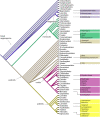
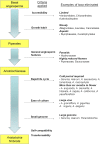

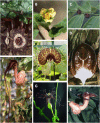
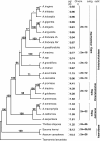
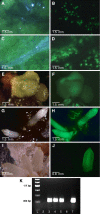


Similar articles
-
Insights into angiosperm evolution, floral development and chemical biosynthesis from the Aristolochia fimbriata genome.Nat Plants. 2021 Sep;7(9):1239-1253. doi: 10.1038/s41477-021-00990-2. Epub 2021 Sep 2. Nat Plants. 2021. PMID: 34475528 Free PMC article.
-
Floral MADS-box protein interactions in the early diverging angiosperm Aristolochia fimbriata Cham. (Aristolochiaceae: Piperales).Evol Dev. 2019 Mar;21(2):96-110. doi: 10.1111/ede.12282. Epub 2019 Feb 8. Evol Dev. 2019. PMID: 30734997
-
Gene expression underlying floral epidermal specialization in Aristolochia fimbriata (Aristolochiaceae).Ann Bot. 2021 May 7;127(6):749-764. doi: 10.1093/aob/mcab033. Ann Bot. 2021. PMID: 33630993 Free PMC article.
-
Origin and early evolution of angiosperms.Ann N Y Acad Sci. 2008;1133:3-25. doi: 10.1196/annals.1438.005. Ann N Y Acad Sci. 2008. PMID: 18559813 Review.
-
The Sequenced Angiosperm Genomes and Genome Databases.Front Plant Sci. 2018 Apr 13;9:418. doi: 10.3389/fpls.2018.00418. eCollection 2018. Front Plant Sci. 2018. PMID: 29706973 Free PMC article. Review.
Cited by
-
Model Species to Investigate the Origin of Flowers.Methods Mol Biol. 2023;2686:83-109. doi: 10.1007/978-1-0716-3299-4_4. Methods Mol Biol. 2023. PMID: 37540355
-
Flower Development and Perianth Identity Candidate Genes in the Basal Angiosperm Aristolochia fimbriata (Piperales: Aristolochiaceae).Front Plant Sci. 2015 Dec 11;6:1095. doi: 10.3389/fpls.2015.01095. eCollection 2015. Front Plant Sci. 2015. PMID: 26697047 Free PMC article.
-
Evolution of the Subgroup 6 R2R3-MYB Genes and Their Contribution to Floral Color in the Perianth-Bearing Piperales.Front Plant Sci. 2021 Apr 9;12:633227. doi: 10.3389/fpls.2021.633227. eCollection 2021. Front Plant Sci. 2021. PMID: 33897722 Free PMC article.
-
Floral biology and ovule and seed ontogeny of Nymphaea thermarum, a water lily at the brink of extinction with potential as a model system for basal angiosperms.Ann Bot. 2015 Feb;115(2):211-26. doi: 10.1093/aob/mcu235. Epub 2014 Dec 14. Ann Bot. 2015. PMID: 25497514 Free PMC article.
-
Insights into angiosperm evolution, floral development and chemical biosynthesis from the Aristolochia fimbriata genome.Nat Plants. 2021 Sep;7(9):1239-1253. doi: 10.1038/s41477-021-00990-2. Epub 2021 Sep 2. Nat Plants. 2021. PMID: 34475528 Free PMC article.
References
-
- Kellogg EA, Shaffer HB. Model organisms in evolutionary studies. Syst Biol. 1993;42(4):409–414. doi: 10.1093/sysbio/42.4.409. - DOI
Publication types
MeSH terms
LinkOut - more resources
Full Text Sources
Other Literature Sources
Research Materials

